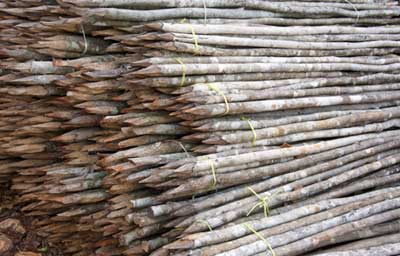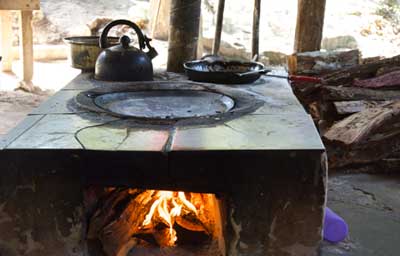Aprovechamiento forestal sustentable en el ejido San Agustín
 Introducción En el año 1965, don Benustiano Cutz Mex llegó desde la región henequenera del ejido Tekantó, en el centro-norte del Estado de Yucatán, para iniciar una nueva comunidad. En aquel entonces, el ejido Tekantó estaba solicitando nuevas tierras como respuesta al crecimiento de su población, pero lo cierto es que ya no había más tierras para una nueva dotación. Fue entonces que el gobierno federal propuso la entrega de 37 mil hectáreas de terrenos nacionales en el sur-oeste del estado para fundar un nuevo ejido y una comunidad. La oferta era tentadora, una gran extensión de tierras que los habitantes de Tekantó estaban necesitando. Los obstáculos eran muchos, era una tierra lejana, no había caminos ni servicios, solo una selva exuberante a la que pocos querían ir. Pese a esas condiciones, unas cien personas llegaron desde Tekantó para fundar el ejido que bautizaron San Agustín, y su comunidad Salvador Alvarado pensada para que vivan unas seiscientas personas. Sin embargo, las condiciones del ambiente eran hostiles, y al poco tiempo de iniciar la gente comenzó a regresarse a Tekantó hasta solo quedar siete personas en la comunidad, entre ellas don Benustiano Cutz Mex. Hoy son 360 ejidatarios en el padrón del Registro Agrario Nacional, de los cuales solo 29 viven en la comunidad, y junto con avecindados la población de Salvador Alvarado es algo menor a cien habitantes. Desde 1994 en adelante, los subsidios de PROCAMPO fomentaron un proceso de desmonte en la zona para incorporar tierras agrícolas, pero en pocos años los controles de verificación comenzaron a ser más espaciados en el tiempo y los ejidatarios de San Agustín automáticamente dejaron de desmontar. A partir de 2007, CONAFOR otorgó apoyos al ejido en proyectos de manejo forestal y pago por servicios ambientales, en parte debido a la gran extensión de selvas que por diferentes razones aún se conservan. En esos años, Claudio Franco Chulín, quien había sido visitador de la Procuraduría Agraria y conocía muy bien la zona, formaba parte de la directiva de Bioasesores, una asociación civil que brinda asistencia técnica en manejo de recursos naturales y desarrollo comunitario, entre otras actividades. Don Benustiano era el presidente del comisariado ejidal, y a su vez Secretario de Nukuch K’áax, otra asociación civil de productores agrosilvopstoriles provenientes de varios ejidos de la zona. Las condiciones fueron propicias para que en 2006, Bioasesores junto con el Ejido San Agustín, realizaran las primeras solicitudes de apoyo para emprendimientos forestales ante CONAFOR, de los cuales se aprueban algunos relacionados con reforestación, compensación ambiental por cambio de uso del suelo en terrenos forestales y pago por servicios ambientales. En el año 2009 se presenta una solicitud de apoyo para elaborar un plan de aprovechamiento forestal sustentable en la vasta extensión de selvas bien conservadas que caracterizan hoy a estas tierras. En sus inicios, los habitantes de Salvador Alvarado no tenían claro el alcance y los beneficios que el proyecto tenía, ya que en la región no existían iniciativas similares. Un sentimiento generalizado era que sería para beneficio de los ejidatarios y no de toda la comunidad. Aunado a ello, la idea de conservación de la selva ya había comenzado a ser parte de una visión común en la población que empezaba a soñar con un proyecto ecoturístico, y en parte por no conocer la actividad, a la propuesta de hacer aprovechamiento la asociaban erróneamente con deforestación. Quienes creyeron en el proyecto siguieron trabajando, y un primer estudio de mercado les indicaba que lo ideal sería comenzar con la producción de carbón. Para esto, una selva con crecimiento secundario en los linderos con otro ejido parecía cumplir con los requisitos que buscaban.
En noviembre de 2011 fue autorizado el aprovechamiento forestal, después de dos años de gestiones ante SEMARNAT. Sin embargo, aún faltaba la manifestación de impacto ambiental que se aprobó en 2013, cuya elaboración fue realizada en dos ocasiones por el equipo de Bioasesores, y es entonces cuando comienza la intervención de la selva. De cualquier forma no fue tiempo perdido, ya que con el financiamiento de otros proyectos, como el de “Diversificación del aprovechamiento forestal en el NCPA San Agustín, Tekax” financiado por el Programa de Pequeñas Donaciones, fue adquirido un aserradero portátil, se realizaron capacitaciones sobre medición de árboles y sus tasas de crecimiento, cosecha con mínimo impacto, producción de carbón, y hasta cómo elaborar solicitudes de apoyo. También se realizaron intercambios con los ejidos Noh Bec (Quintana Roo) y 20 de Noviembre (Campeche), y se compró materiales necesarios para el trabajo, entre ellos los hornos para la producción de carbón.
Tuvieron que pasar cuatro años desde que se llevó a cabo el inventario hasta que se vendió el primer producto, que curiosamente no fue de carbón, sino de tutores (varas de 5 cm de diámetro). La venta de la primera carga de tutores a la empresa Valle del Sur (Municipio Tekax) posiblemente es el primer hito importante en el proyecto, porque demostró en la comunidad que sí es posible tener recursos económicos sin destruir el monte, y eso generó que más pobladores de Salvador Alvarado se acercaran para participar. Esto también demostró que no era solo para ejidatarios, y comenzaron a sumarse jóvenes, hijos y nietos de ejidatarios, y las mujeres de la comunidad. Para dar fortaleza al proceso y con el objeto de que no sean solo ejidatarios quienes pudieran trabajar, se conformó la sociedad Productores Forestales de San Agustín, Tekax SPR de RL. Esta sociedad está conformada por mujeres, jóvenes y avecindados de la comunidad, los cuales toman decisiones en asambleas. La presencia permanente en las zonas bajo manejo también representó un beneficio porque redujo la presión de cazadores furtivos del ejido vecino. Lecciones aprendidasHumberto González Parra, asesor técnico de Bioasesores AC, comenta que ha participado en muchos procesos donde se obtuvo el permiso pero nunca se realizó aprovechamiento. Como menciona Humberto, “los técnicos pueden hacer el inventario, sin embargo hace falta más que un inventario para lograr el aprovechamiento sustentable, mucho más que eso, y en el caso de San Agustín se logró, porque no se dejó de dar seguimiento”. En San Agustín se insistió mucho en capacitaciones mientras se esperaba tener la aprobación legal para llevar a cabo el aprovechamiento, ya que la factibilidad técnica, social y ambiental existía. Don Benustiano Cutz Mex remarca la importancia de capacitar a los nuevos representantes del comisariado que inicia un nuevo período de gestión, así como a las generaciones de jóvenes de la comunidad, y esto es algo que siempre se considera en San Agustín. Una lección importante es que se debe conocer muy bien las leyes que regulan la actividad para no cometer errores. Por ejemplo, cuando se elaboró la manifestación de impacto ambiental, por error se mencionó la presencia del grisón (Galictis vittata), y lo cierto es que ni siquiera se tiene evidencia de esa especie, pero ese error complicó la aprobación. SEMARNAT indicó que se debía excluir al menos 700 hectáreas como compensación, casi un tercio de la superficie total del área de aprovechamiento (2,254 hectáreas). Las más de mil hectáreas de conservación con las que el ejido cuenta no podían ser consideradas como área de compensación porque se ubican lejos del área de aprovechamiento. La propuesta aceptada fue asignar otras 700 hectáreas de conservación contiguas al área de aprovechamiento. Finalmente, las consecuencias fueron inesperadamente positivas, y hoy las 700 hectáreas cuentan con un programa de PSA de fondos concurrentes, además de otra área que cuenta con PSA por parte de CONAFOR. Cuenta Don Benustiano Cutz Mex, “una vez vino un visitante y nos dijo ustedes son ricos, están encima de un montón de dinero, y yo le pregunté ¿dónde está? Me respondió, la riqueza está ahí, nada más que tienen que abrir los ojos. Para mí esto es un sueño que se está haciendo realidad. No hemos llegado a la meta, pero estamos en el camino de lograrlo”. |





















